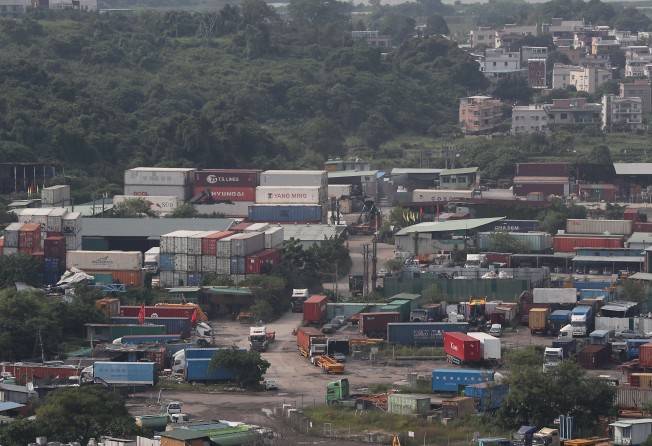Study on clearing Hong Kong’s brownfield sites won’t be ready for nearly two years

A study on the feasibility of transforming brownfield sites such as sprawling container yards into land for housing is not expected to be completed until around mid-2018, a senior development official revealed on Wednesday amid the Wang Chau development saga.
The announcement came at a press conference attended by the chief executive, the financial secretary, the transport and housing minister and two senior planning and development officials. The conference was arranged after the government controversially set aside a plan to develop public housing on an environmentally damaged brownfield site in Wang Chau, Yuen Long, to prioritise developing a heavily vegetated green belt site nearby.
Although the five denied having given in to pressure from powerful rural leaders with vested interests in the brownfield site, they failed to explain why they deferred the development after village strongmen voiced their opposition but moved on with the green belt site development despite strong opposition from residents in three affected villages who will be displaced.
Speaking about the difficulties in developing brownfields, which involved clearing out businesses such as garages, car parks and container storages, the acting secretary for development, Eric Ma Siu-cheung, said the study would take the Hung Shui Kiu New Development Area in Yuen Long as a test case for releasing more land for flats on brownfield sites.
Ma added that another comprehensive study on all brownfield sites across Hong Kong and their usage would start next year.
The government confirmed it decided to defer the Wang Chau brownfield project in early 2014, but the Post learnt that in reports up until the decision, the government said the project was expected to be completed in 2026-27.
The five top officials ignored questions on whether the expected completion year was still on the agenda.
“Although it takes time to deal with brownfield issues ... when we find a solution, we can start the [Wang Chau project] as soon as possible,” Chief Executive Leung Chun-ying said.
Newly elected lawmaker Eddie Chu Hoi-dick, who first raised the allegations of a government-business-rural-triad collusion, has been urging the government to develop the brownfield site first. He is now under police protection after receiving death threats.
It was also revealed that one of Hong Kong’s major developers, New World Development Company, owns a green belt site adjacent to the one in the government’s development plan and applied to the Town Planning Board in August last year to build private housing on the site. The application is now being considered.
If the government’s development plan goes ahead, the company may be able to enjoy some of the infrastructure provided by public money.
Many are worried that the government’s development of green belt land will encourage private developers who own such sites but which have previously been difficult to develop given the principle of maintaining such areas as environmental buffer zones.
In the press conference, Leung said he did not know New World owned the adjacent site and denied collusion.
In a press conference on Wednesday to announce the company’s results, New World chairman Henry Cheng Kar-shun denied any transfer of benefits between the company and the government.
“We are also the victim,” Cheng said.
He said the company bought a 170,000 sq ft green belt site in Wang Chau in the 1990s but had failed in multiple applications to use it over the following two decades.
Cheng said the government had resumed about 70,000 sq ft of the site for the controversial development plan and rezoned the resumed site for public housing development in 2014.
“We now only have a small site of 100,000 sq ft,” Cheng said, referring to the adjacent site on which New World has applied to develop housing. But one newspaper report said New World owned over 700,000 sq ft in Wang Chau.
“There is no collusion, there is no transfer of benefits. We went through proper channels for the largest benefits to the company.”
Cheng was one of the first tycoons to support Leung during his campaign for chief executive.